
Fast, affordable Internet access for all.
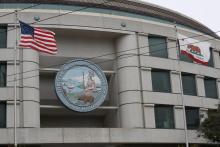
In 2021, California passed Senate Bill 156, an ambitious plan allocating $6 billion to shore up affordable broadband access throughout the state.
Among the most notable of the bill’s proposals was a plan to spend $3.25 billion on an open-access statewide broadband middle-mile network backers say could transform competition in the state.
An additional $2 billion has also been earmarked for last mile deployment. Both components will be heavily funded by Coronavirus relief funds and federal Broadband Equity, Access, and Deployment (BEAD) subsidies as well as California State Government grants – with all projects to be finished by December 2026 as per federal funding rules.
But while California’s proposal has incredible potential, activists and digital equity advocates remain concerned that the historic opportunity could be squandered due to poor broadband mapping, a notable lack of transparency, and the kind of political dysfunction that has long plagued the Golden State.
Massive Scale, Big Money, Endless Moving Parts
Still, California’s prioritization of open access fiber networks could prove transformative.
Data routinely indicates that open access fiber networks lower market entry costs, boost overall competition, and result in better, cheaper, faster Internet access. Unsurprisingly, such networks are often opposed by entrenched regional monopolies that have grown fat and comfortable on the back of muted competition.
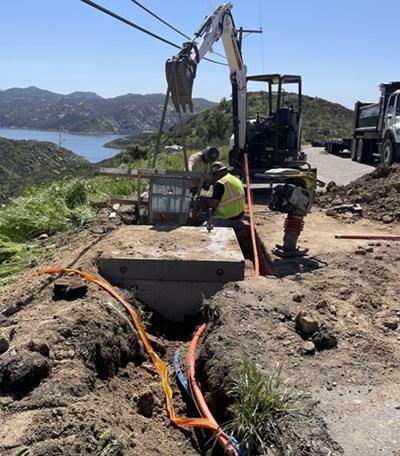
The state’s Middle-Mile Broadband Initiative (MMBI) is being managed by the California Department Of Technology (CDT), which maintains an interactive map documenting the progress of the planned deployment of what was supposed to be 10,000 miles of fiber.
According to recent comments by the CDT, 83 percent of the middle-mile network is currently under contract for construction and leases. Late last month, CDT announced it would be doling out $400 million to Lumen (formerly CenturyLink) to deploy 1,900 miles of network infrastructure key to the state’s middle mile ambitions.
Lumen – a somewhat ironic participant given its history of anticompetitive behavior and efforts to undermine community-owned broadband networks – says it will be pulling new 288-count fiber into existing conduit for all 1,900 miles of the project, with the goal of improved access to hundreds of California communities by the end of 2026.
Lumen’s contribution is one small piece of the puzzle. To help expand this new middle mile connectivity out to the last mile, SB 156 also created California's Golden State Connect Authority (GSCA) – a joint powers authority consisting of 40 rural member counties, governed by an elected supervisor from each county.
The organization’s mandate: to ensure every member county has a plan to expand affordable broadband access, provide the resources the counties need to achieve those goals, and to advocate for the deployment of open access, municipal broadband networks statewide.
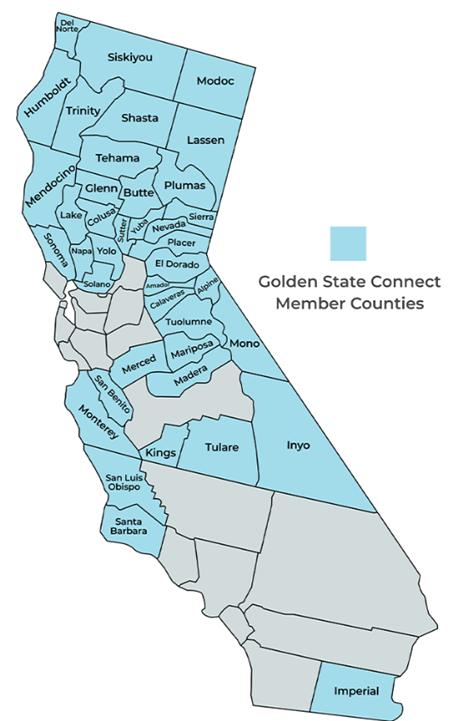
Last year GSCA employed the help of UTOPIA Fiber, an interlocal agency owned by 11 Utah cities.
UTOPIA, no stranger to the deployment of open access fiber at scale, is providing consulting services ranging from high-level network design and engineering, to construction and project management aid.
Kimberly McKinley, Chief Marketing Officer for UTOPIA Fiber, told ILSR that the GSCA applied for funding across nearly all of its 40 county membership, and that winning bidders should be selected by March. The end result should help drive competition to traditionally underserved and rural areas long neglected by regional telecom monopolies.
“Investing in publicly-owned Open Access middle mile fiber networks enables private sector competition while delivering competitive options for consumers and businesses,” McKinley told ILSR.
“Not only do they extend the reach of broadband networks, promising to connect millions more in California, they also provide critical transport of data and can serve as the backbone for advanced wireless, public safety, education, and telehealth networks as well,” she added.
Such a massive project has no shortage of moving parts–or complex disagreements over how to best utilize limited resources.
For example, Siskiyou Telephone Company and its subsidiary Golden Bear Broadband recently filed an objection to a $46 million GSCA project in Siskiyou County that will connect 3,400 unserved households. Siskiyou insists it’s best positioned–and already planned to–upgrade many of these premises, and the GSCA effort created bureaucratic obstacles to its plans.
Trouble In Paradise
Whether California’s ambitious gambit delivers on its promises remains to be seen, and the project hasn’t been without its share of early controversy. California activists have long insisted the maps used by the CDT to determine broadband availability in the state are fatally flawed, resulting in data that downplays limited competition at the hands of monopoly power.
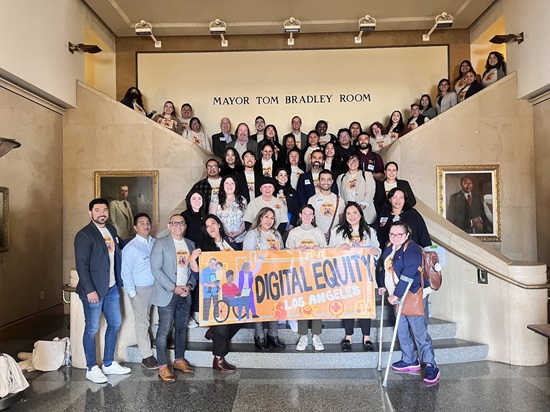
It’s difficult to fix a problem you’ve yet to accurately measure, and giant telecom monopolies from AT&T to Comcast have long fought efforts at more accurate mapping, wary that it would only highlight high prices, spotty access, and slow speeds due to market failure. The big monopolies also have a long history of taking subsidies, but failing to deliver the finished networks.
The heavily monopolized U.S. broadband market has also long been plagued by “digital discrimination,” or the act of selectively avoiding low-income or minority and poor communities when determining broadband expansion. Organizations like the National Digital Inclusion Alliance (NDIA) have documented the problem in U.S. cities from coast to coast.
Those concerns were brought to the foreground over the summer, when CDT officials quietly announced they’d made significant cuts to the state’s affordable broadband expansion plan.
Blaming inflation and rising construction costs, the state’s renewed budget called for a 17 percent reduction in planned broadband investment, on average, across the state. The state, or its advisors, may have been overly ambitious in the initial announcements of where networks would be deployed.
Despite no meaningful public input, state officials announced that the 10,000 mile middle mile network would now be 8,300 miles, and that the the costs of the network would be 40 percent higher than originally estimated–purportedly due to inflation.
In short: the state made it clear the project would be both more expensive and less ambitious than originally proposed.
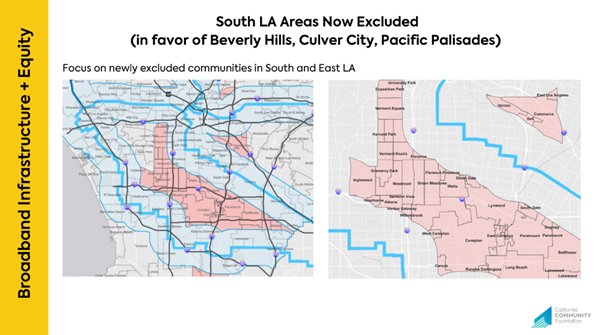
A series of map updates outlining the changes alarmed activists, who say the cuts disproportionately impacted minority and marginalized communities, which raises troubling questions as to how the CDT had determined which communities would see funding priority.
“Inaccurate maps have long plagued equitable broadband deployment,” the EFF’s Chao Liu noted in September.
"With the amount of funding soon to be made available, the California Department of Technology’s middle mile map could threaten to turn inaccuracy into intergenerational discrimination.”
While the CDT and California Governor Gavin Newsom said they’d restore some of the missing funding after months of activist pressure, activists ILSR has spoken to aren’t so sure that’s actually going to happen. They say the state has failed consistently to transparently engage with the community and openly discuss its decision making processes.
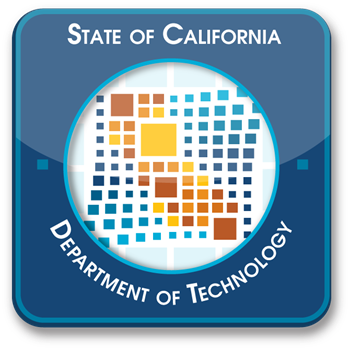
“I will say that the experience of communities and localities trying to take CDT at their word that they intend to partner with us has been frustrating to say the least,” Shayna Englin, Director of the Digital Equity Initiative at the California Community Foundation told ILSR in a phone interview.
Englin noted that CDT consistently makes changes to its broadband maps without explaining what changed or why. She also noted the state has repeatedly failed to adequately document the width, scope, and details of its contracts and lease agreements with various providers, complicating efforts for those trying to best position themselves for funding.
“In every single instance the CDT and all the powers that be promise transparency and partnership,” Englin said, referencing the roughly 20 meetings with state leaders her organization has participated in. “What actually gets delivered is none of that.”
In a late October meeting, CDT officials appeared to place at least some of the blame for mapping changes on a “geographic information system glitch,” claimed that a phased approach to construction created confusion that some segments had been reprioritized, and insisted that state leaders would restore any lost funding at a later date.
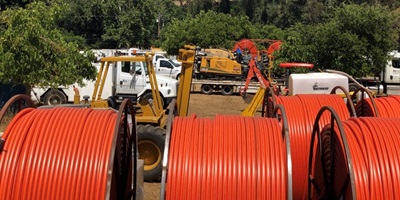
But Liu and Englin were quick to clarify that the agency has shifted the middle-mile deployment into two phases. The first phase of deployment has been adequately funded, but the second phase has not. Many marginalized communities were shoveled off into the second phase, raising questions about whether they’ll be funded at all. Meanwhile, more affluent and less diverse areas, like Beverly Hills, suddenly saw a notable uptick in deployment on the CDT’s ever-shifting maps, again with no meaningful explanation by the agency as to what had shaped the state’s decision-making process.
Still Broken After Months Of Heated Backlash
“The state has not adequately addressed the concerns,” Liu told ILSR. “The original maps were not restored and the CPUC and CDT moved forward with their plans, signing contracts and disbursing funds based on the new, not as great maps. In response to an outcry from the local communities the Governor has promised to make a budget request to build out the sections that were cut. The big wrinkle in this is California is almost definitely headed into a steep budget deficit so making any ask to spend large chunks of money will be difficult.”
The CDT did not respond to repeated ILSR requests for comment.
Recently adjusted for inflation, the money allotted to the middle-mile initiative alone is now $3.87 billion– including a $73 million middle-mile grant from NTIA. California is also poised to receive $1.8 billion in federal Broadband Equity Access and Development Program (BEAD) funding.
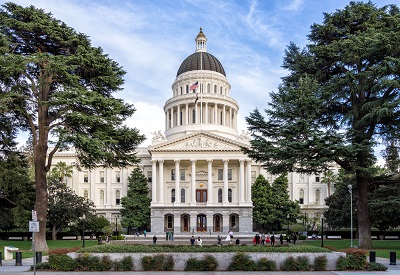
Yet Englin said the CDT provides no meaningful insight into what money has been spent, what it’s being spent on, or how key decisions are being made regarding what will probably be a once-in-a-lifetime funding opportunity. Even signed contracts aren’t being made available for transparent public review.
“There are $1.8 billion in signed contracts,” Englin noted. “You have spent that money. What segments are covered by that? What are the terms and conditions? How this network is actually being built completely undermines the last mile projects that it's supposed to be supporting.”
Englin noted the lack of transparency means potential partners have no idea how many strands they’ll be able to access or where those access points are, potentially impacting efforts to secure needed financing for a litany of potential projects across the state.
“This process is so broken it can’t just be papered over,” Englin said. “Throwing more money down the rabbit hole won’t fix what’s rotten at the bottom: bad data, no transparency, no accountability, and no community engagement.”
If successful, California’s gambit could dramatically transform broadband competition and affordability. But if transparency, community involvement, and accurate data aren’t quickly prioritized, activists say the mammoth project could fall well short of its potential–especially when it comes to minority communities long trapped on the wrong side of the digital divide.
Header image of California Public Utilities Commission building courtesy of Wikimedia Commons, Attribution-ShareAlike 3.0 Unported
Inline map of Golden State Connect Authority member counties map courtesy of Golden State Connect Authority website
Inline image of middle mile construction work courtesy of Caltrans website
Inline image of fiber spools courtesy of California Public Utilities Commission website
